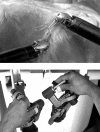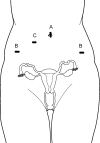Preliminary experience with robot-assisted laparoscopic staging of gynecologic malignancies
- PMID: 15984701
- PMCID: PMC3015578
Preliminary experience with robot-assisted laparoscopic staging of gynecologic malignancies
Abstract
Objective: To evaluate the feasibility of integrating robot-assisted technology in the performance of laparoscopic staging of gynecologic malignancies.
Methods: Seven patients underwent robot-assisted laparoscopic staging procedures for gynecologic cancers. Data were collected and analyzed as a retrospective case series analysis.
Results: We attempted 7 robot-assisted laparoscopic staging procedures with no conversions to laparotomy. The median lymph node count for lymphadenectomy was 15 (range, 4 to 29). Mean operating time was 257 minutes (range, 174 to 345). The average estimated blood loss was 50 mL. One patient developed sinusitis and required intravenous antibiotics. The median hospital stay was 2 days.
Conclusion: Robot-assisted laparoscopic staging is a feasible technique that may overcome the surgical limitations of conventional laparoscopy.
Figures






References
-
- Reynolds RK, Burke WM. The evolving role of laparoscopic surgery for treatment of gynecologic masses and cancers. Female Patient. 2004;29(4):25–32
-
- Eltabbakh GH, Shamonki MI, Moody JM, Garafano LL. Laparoscopy as the primary modality for the treatment of women with endometrial carcinoma. Cancer. 2001;91(2):378–387 - PubMed
-
- Querleu D, Papageorgiou T, Lambaudie E, Sonoda Y, Narducci F, Leblanc E. Laparoscopic restaging of borderline ovarian tumors: results of 30 cases initially presumed as stage IA borderline ovarian tumour. BJOG. 2003;110:201–204 - PubMed
-
- Carpentier A, Loulmet D, Aupecele B, Berrebi A, Relland J. Computer-assisted cardiac surgery. Lancet. 1999;353:379–380 - PubMed
-
- Degueldre M, Vandromme J, Huong PT, Cadiere GB. Robotically-assisted laparoscopic microsurgical tubal reanastomosis: a feasibility study. Fertil Steril. 2000;74:1020–1022 - PubMed
MeSH terms
LinkOut - more resources
Full Text Sources
